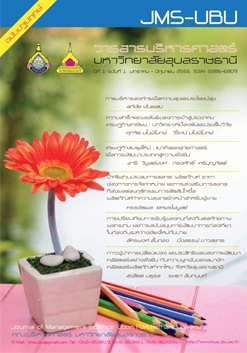Transformational Leadership, Effectiveness of Sustainable Cluster Development and Commitment of Silk Product Cluster Members in Ubon Ratchathani Province.
Main Article Content
Abstract
This mix-method study focuses on the transformational leadership, sustainable effectiveness of silk product cluster in Ubon Ratchathani, and cluster members’ commitment. In addition, it aims to find the connection between the transformational leadership, effectiveness of sustainable cluster development, and cluster members’ commitment.
This research is based on qualitative data (interview) and quantitative survey research. The qualitative data is based on words from 6 committee members of UbonRatchathani silk product cluster and 4 officials of the 7th Regional Industrial Promotion Center. The quantitative data is based on information from 32 participants from Ubon Ratchathani silk product group. This paper uses content analysis for analyzing qualitative data and descriptive statistics: percentage; frequency; mean; standard deviation, and Pearson Correlation Coefficient for analyzing quantitative data.
The qualitative results reveal that cluster leaders have pursued transformational leadership efficiently. They are good consultants and inspiration for their cluster members and they also support cluster members to work toward their goals systemically. Furthermore, the leaders enhance effectiveness of sustainable cluster development; evidenced as members’ joined production and marketing plans and activities resulting in increased income for member participated, and thus, the leaders are influence to cluster members’ commitment.
The survey found that the transformational leadership, effectiveness of sustainable cluster development, and cluster members’ commitment are at high level: =3.81,
=3.48,
=4.11, respectively. The connection between transformational leadership to effectiveness of sustainable cluster development and cluster members’ commitment, and, the connection between sustainable effectiveness and cluster members’ commitment are all positive as the following correlations: r=.466, r=.456 r=.570.
In conclusion, the qualitative results are consistent with the quantitative survey. The qualitative results indicated that the cluster leaders are efficiently transformational leadership and enhance effectiveness of sustainable cluster development of the silk cluster, so that, they are influence to cluster members’ commitment. Likewise, the survey support the qualitative results with all high levels of the transformational leadership, effectiveness of sustainable cluster development of silk product cluster in Ubon Ratchathani, and cluster members’ commitment. In addition, the correlations show all positive connection between these tree variables.
Downloads
Article Details
References
ชาญ รัตนะพิสิฐ.(2551) ปัจจัยที่ส่งผลต่อประสิทธิผลขององค์การของผู้ประกอบการวิสาหกิจขนาดกลางและขนาดย่อมในเขตกรุงเทพมหานครและปริมณฑล. วิทยานิพนธ์วิทยาศาสตรมหาบัณฑิต (จิตวิทยาอุตสาหกรรม) มหาวิทยาลัยเกษตรศาสตร์.กรุงเทพมหานคร.
ฉัตรศิริ ปิยะพิมลสิทธิ์. (2554). การวิจัยและการใช้ SPSS เพื่อการวิจัย.ค้นเมื่อ 1 พ.ย. 2554 จาก
www.202.143.161.22/SPSS_doc/SPSS6.pdf.
ณัฎฐา หงษ์ดำเนิน. (2549). การวิเคราะห์สถานการณ์ด้านปัจจัยแวดล้อมทางธุรกิจของเครือข่ายวิสาหกิจสิ่งทอ จังหวัดชัยภูมิ. วิทยานิพนธ์เศรษฐศาสตร์มหาบัณฑิต (เศรษฐศาสตร์ธุรกิจ) สาขาวิชาการเศรษฐศาสตร์ธุรกิจมหาวิทยาลัยเกษตรศาสตร์ .กรุงเทพมหานคร.
ทิพวรรณ โอษคลัง. (2549). ความสัมพันธ์ระหว่างพฤติกรรมภาวะผู้นำการเปลี่ยนแปลงของผู้บริหารสถานศึกษา กับ
ความผูกพันต่อสถานศึกษาของครู สังกัดสำนักงานเขตพื้นที่การศึกษาเลย เขต1. วิทยานิพนธ์คุรุศาสตร์
มหาบัณฑิต สาขาการบริหารการศึกษา มหาวิทยาลัยราชภัฎเลย.
ธนาพร เมธาภิวัฒน์. (2545) .ภาวะผู้นำแบบปฏิรูปของพยาบาลหัวหน้าหอผู้ป่วยและประสิทธิผลทีมงาน: กรณีศึกษา
วิทยาลัยพยาบาลแพทย์ศาสตร์กรุงเทพมหานครและวชิรพยาบาล. วิทยานิพนธ์ศิลปศาสตร์มหาบัณฑิต สาขาจิตวิทยาอุตสาหกรรมและองค์การ มหาวิทยาลัยธรรมศาสตร์.
เบญจพล มีเงิน. (2551). คลัสเตอร์อุตสาหกรรม: การได้มาซึ่งความได้เปรียบเชิงการแข่งขันขององค์การธุรกิจ จากการ
รวมกลุ่มคลัสเตอร์อุตสาหกรรมสิ่งทอ ในประเทศไทย. ดุษฎีนิพนธ์ ปรัชญาดุษฎีบัณฑิต สาขาบริหารธุรกิจ. มหาวิทยาลัยรามคำแหง
ประทานพร ทองเขียว. (2546). ความสัมพันธ์ระหว่างความเป็นผู้นำแบบเน้นการเปลี่ยนแปลง กับประสิทธิผลของ
หน่วยงาน พฤติกรรมการเป็นสมาชิกที่ดีขององค์กรและความผูกพันต่อองค์การของเจ้าหน้าที่โรงพยาบาล. วิทยานิพนธ์วิทยาศาสตรมหาบัณฑิต สาขาจิตวิทยาอุตสาหกรรมและองค์การ บัณฑิตวิทยาลัย, มหาวิทยาลัยเชียงใหม่ .
พิชัย อุ่นนันกาศ. (2552). ความสัมพันธ์ระหว่างการรับรู้รูปแบบภาวะผู้นำของผู้บังคับบัญชา กับความผูกพันต่อองค์กรของพนักงานบริษัทลักกี้ยูเนี่ยมฟูดส์ จำกัด. วิทยานิพนธ์รัฐศาสตรมหาบัณฑิต มหาวิทยาลัยเชียงใหม่.
รัตติกรณ์ จงวิศาล. (2549). ภาวะผู้นำของผู้ประกอบการไทย. วารสารสังคมศาสตร์และมนุษยศาสตร์ ปีที่ 32 พฤษภาคม – สิงหาคม 2549 มหาวิทยาลัยเกษตรศาสตร์ . กรุงเทพมหานคร.
ศูนย์ส่งเสริมอุตสาหกรรมภาคที่ 7. (2553). รายงานผลโครงการรวมกลุ่มและเชื่อมโยงอุตสาหกรรมผลิตภัณฑ์จากไหม
จังหวัดอุบลราชธานี .
ศิริพร โสภณธรรมธร. (2548). ผู้นำแบบปฏิรูป กระบวนการกลุ่ม ความกลมเกลียวของสมาชิกกลุ่ม และผลลัพธ์จากการทำงานของกลุ่มผู้ผลิตสินค้า “ หนึ่งตำบล หนึ่งผลิตภัณฑ์”. วิทยานิพนธ์ศิลปศาสตร์มหาบัณฑิต สาขาวิชา
จิตวิทยาอุตสาหกรรมและองค์การ ภาควิชาจิตวิทยา มหาวิทยาลัยธรรมศาสตร์. กรุงเทพมหานคร.
ศักดิ์สิทธิ์ บุศยพลากร. (2550). การติดตามและประเมินผล การพัฒนาการรวมกลุ่มและเชื่อมโยงอุตสาหกรรมเครื่อง
หนัง กรุงเทพมหานคร . บทความการวิจัยกรมส่งเสริมอุตสาหกรรม กระทรวงอุตสาหกรรม.
สำนักงานพัฒนาเศรษฐกิจและสังคมแห่งชาติ. (2548). สำนักงานคณะกรรมการพัฒนาขีดความสามารถในการแข่งขัน
ของประเทศและสำนักงานพัฒนาขีดความสามารถในการแข่งขันทางเศรษฐกิจ. การพัฒนาเครือข่ายวิสาหกิจ
แนวคิดและแนวทางการพัฒนา. กรุงเทพมหานคร.
สุมาลี สันติพลวุฒิ และคณะ. (2550) .โครงการการติดตามและประเมินผลโครงการพัฒนาการรวมกลุ่มอุตสาหกรรม.
ศูนย์วิจัยเศรษฐศาสตร์ คณะเศรษฐศาสตร์ มหาวิทยาลัยเกษตรศาสตร์
สถาบันคีนันแห่งประเทศไทย .(2549). คู่มือการพัฒนาคลัสเตอร์ เพื่อยกระดับความสามารถในการแข่งขันของภาค
ผลิตและบริการ. เอกสารภายใต้โครงการจัดทำแผนที่เครือข่ายวิสาหกิจ (Cluster Mapping) สำนักงาน
คณะกรรมการพัฒนาการเศรษฐกิจและสังคมแห่งชาติ. กรุงเทพมหานคร.
อิสระ บุญญะฤทธิ์. (2547). การศึกษาความสัมพันธ์ระหว่างภาวะผู้นำ สมรรถนะ บรรยากาศองค์การ และประสิทธิภาพผลของหัวหน้างานระดับต้น. วารสารสังคมศาสตร์ คณะมนุษย์ศาสตร์ 30, มกราคม – เมษายน 2547,
มหาวิทยาลัยเกษตรศาสตร์
อาคม ไตรพยัคฆ์.. (2549). ความผูกพันต่อองค์กร ของข้าราชการตำรวจ กองตำรวจสื่อสาร. วิทยานิพนธ์ ศิลป- ศาสตรมหาบัณฑิต สาขารัฐศาสตร์และรัฐประศาสนศาสตร์ มหาวิทยาลัยเกษตรศาสตร์
อัญชลี มากบุญส่ง. (2540). ความสัมพันธ์ระหว่างภาวะผู้นำของหัวหน้ากลุ่มงานการพยาบาลกับประสิทธิผลของกลุ่ม
งานการพยาบาลตามการรับรู้ของหัวหน้าหอผู้ป่วยโรงพยาบาลศูนย์ โรงพยาบาลทั่วไป สังกัดกระทรวงสาธารณสุข. วิทยานิพนธ์ปริญญาพยาบาลศาสตร์มหาบัณฑิต สาขาบริหารการพยาบาล, บัณฑิตวิทยาลัย. จุฬาลงกรณ์มหาวิทยาลัย.
Allen, N.J. & Meyer, J.P.(1990). The measurement and antecedents of affective, continuance and normative commitment to the organization. Journal of Occupational Psychology, 63: 1-8.
Bass, B.M. and Avolio B.J. (1994). Improving Organizational through Transformation Leadership. California: SAGE Publication Ltd.
Bass, B.M .(1996). A New Paradigm of Leadership. An Inquiry into Transformational Leadership. Virginia:
US. Army Research for Behavioral and Social Science.
Porter,M.E. (1990).The Competitive Advantage of Competition. New York. The Free Press .
Porter,M.E . (1998). Environment and Public Policy On Competition. A Harvard Business Review Book.
Steers R.M. (1991). Introductor to organizational Beharior (4th ed.). New York : Harper Collins Publishers.
